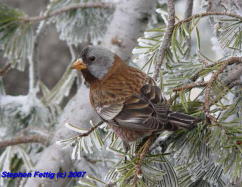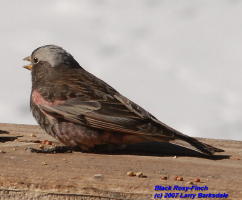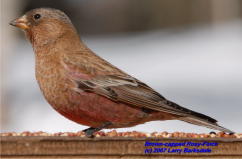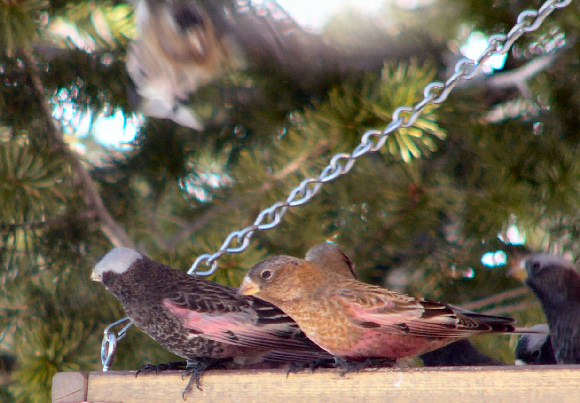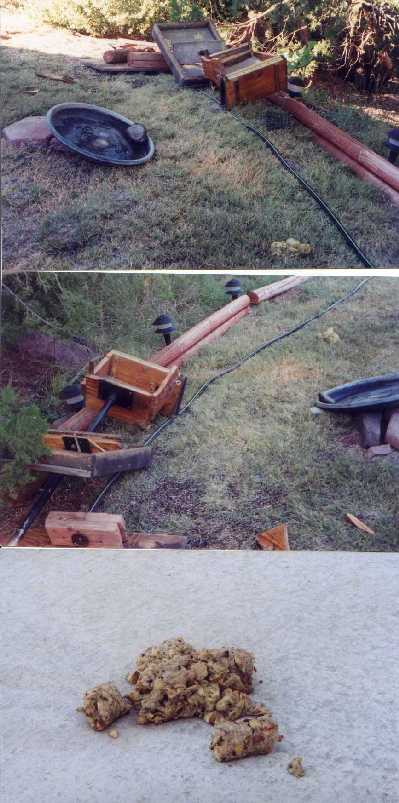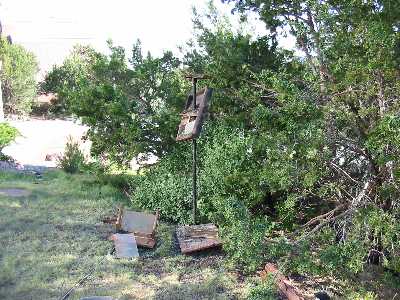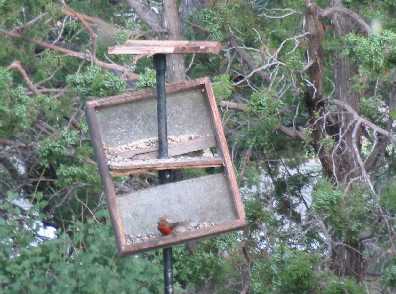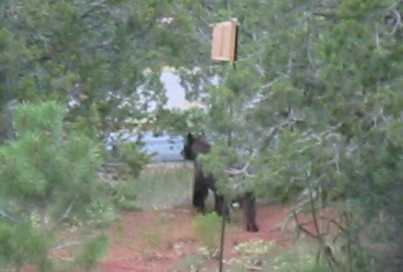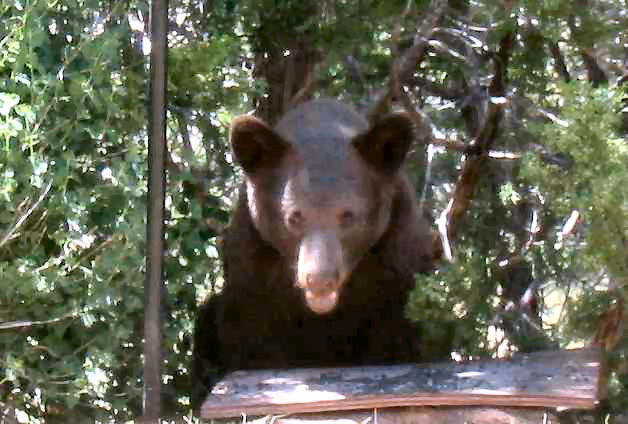Photo CollectionKen and Mary Lou Schneider(Formerly of Cedar Crest, NM 87008) |
The photo below is our first attempt at digiscoping. We took this picture October 17, 2002, of a pair of Evening Grosbeaks at our yard feeder,
shooting through a window, using a Canon A40 and a KOWA 77 mm spotting scope zoomed down to 20X.
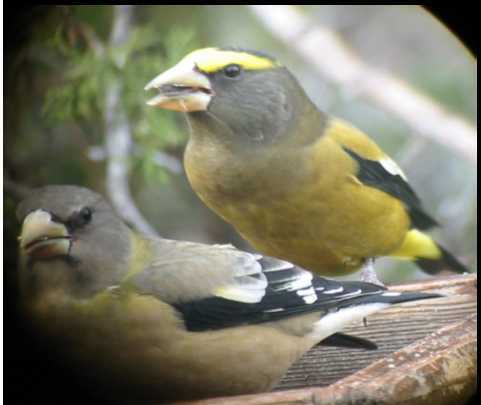
Rosy-Finch Photo Collection
We welcome contributions of Rosy-Finch photos to document all three speciesseen at Sandia Crest. Photographic images remain the property of owners
as designated below and may not be reproduced without permission.
Please provide date, location and photographic equipment (optional).
We also welcome any links to Rosy-Finch photos and information.
Identification of Rosy-Finch Species
Male adults are easiest to separate in the field, so let's start with Steve Fettig's series of photos, that provide comparable views of all three species, and as a bonus, the Coastal or Hepburns subspecies of the Gray-crowned Rosy-Finch. These were all taken at Sandia Crest on the same day, February 11, 2007 and under quite similar lighting conditions. Christopher Taylor's photos were all taken on the same day in mid-December, 2007. The tails of rosy-finches are somewhat forked, and their wings are surprisingly long, with wingtips extending down to cover over half the tail. Black Rosy-Finches tend to be about 1/4 inch shorter from tip of bill to end of tail than the other species, which are about 6 1/4 inches in length. Bill color is usally bright yellow in fall and early winter, becoming darker as winter progresses. Females follow the same patterns but are generally duller than males. Click on the thumbnails for a more detailed view of each bird. See an example of the difficulty that may be encountered in separating the species at this link.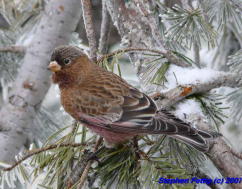 Brown-capped Rosy-Finch Adult (Leucosticte australis)
Brown-capped Rosy-Finch Adult (Leucosticte australis)
Black forehead blends into dark brownish crown. Gray head patch usually
absent, but some show a light area on the sides of crown that does not
extend to the back of head. Males usually have noticeably brighter
underparts than Gray-crowned. Also see Scott Streit's Images of Brown-capped Rosy-Finches
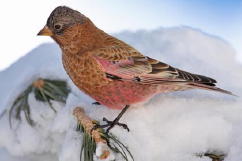
Also see Christopher Taylor's additional Images of Brown-capped Rosy-Finches
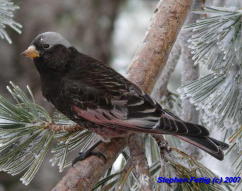 Black Rosy-Finch (Leucosticte atrata)
Black Rosy-Finch (Leucosticte atrata)
Black forehead strongly contrasts with light gray on crown, which
extends to back of head. Black back, throat and upper breast contrast
with extensive pink on belly, rump and edges of wing and tail feathers.
Pink under-tail coverts. Generally has little brown in plumage, but
first winter birds may have a dull or even brownish cast and may be
very difficult to distinguish from Gray-crowned.Also see Scott Streit's Images of Black Rosy-Finches
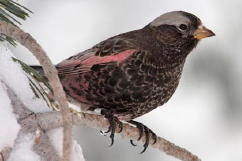
Also see Christopher Taylor's additional Images of Black Rosy-Finches
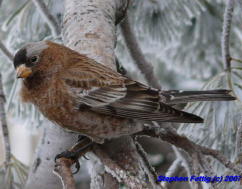 Gray-crowned Rosy-Finch (Interior race, Leucosticte tephrocotis tephrocotis)
Gray-crowned Rosy-Finch (Interior race, Leucosticte tephrocotis tephrocotis)
Note the sharp demarcation between the black forehead and the light
gray crown which does not extend very far down the back of head. While
plumage is usually a rich cinnamon-brown, some are darker and may be
confused with Black Rosy-Finches. Considerably less pink on belly,
wings and rump. The Gray-crowned Rosy-Finch is the species most likely
to be confused with other rosy-finches. Black Rosy-Finch lacks brown
back and breast. Brown-capped lacks gray on head. The amount of gray on
the head is variable. Young birds may be especially difficult to
separate from Brown-capped in the field.Also see Scott Streit's images of Gray-crowned Rosy-Finches
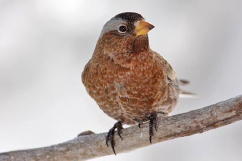
Also see Christopher Taylor's additional Images of Gray-crowned Rosy-Finches
Gray-crowned Rosy-Finch (Coastal or Hepburns race, Leucosticte tephrocotis littoralis)
Differs from the Interior race in having more extensive gray areas on the crown and cheeks. Note contrast between the black chin and light cheeks. Some individuals, possibly first winter birds, may be quite dark on upper back. Like Interior race, the pink on belly, wings and rump is quite subdued.Bob Steele's Images of Gray-crowned subspecies:
Distinguishing Darker Gray-crowned from Black Rosy-finch.
Some immature and female Gray-crowned Rosy-finches can be quite dark, to the point that they look very much like Black Rosy-finches. Conversely, female and first year Blacks may look to be mottled with brown (buffy edges to the contour feathers). Note that the whitish crown of the individual to the left curves down below eye level to the nape of the neck, and its cheeks, upper back and breast are quite uniformly dark to black. The rosy markings on the shoulders (wing coverts), flight feathers, belly and under the tail are quite pronounced, not characteristic of the Gray-crowned Rosy-Finch. Larry Barksdale photographed this Black Rosy-Finch in January, 2007 near Red River, NM.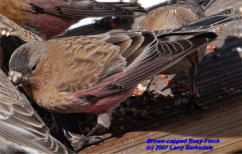 Gray-crowned or Brown-capped?
Gray-crowned or Brown-capped?
Many Brown-capped Rosy-Finches show a light area at the sides of their
crown. It is usually not well-demarcated and blends into the darker
head and nape. The contrast between the black forehead and the crown is
usually not very strong in Brown-capped, while the light area on the
head of the Gray-crowned Rosy-Finch generally stands out and is
uniform all the way around the hind crown. The pink/rosy belly and wing
markings are noticeably more pronounced than on the Gray-crowned, as
exhibited by Larry Barksdale's photo of this Brown-capped Rosy-finch. Now, there's a nice Brown-capped Rosy-Finch!
This is a typical Brown-capped Rosy-Finch. To my eye (individuals can vary quite a bit and other birders may disagree with me), the adult male Gray-crowned tends to have a more cinnamon-brown appearance and the pink takes on an almost "orange" tint as opposed to the warm brown and rosy pink of this Brown-capped Rosy-Finch. Again, see here how the effects of light reflection can "morph" even a typical Brown-capped into something else!Reference:
Patuxent Bird Identification InfoCenter
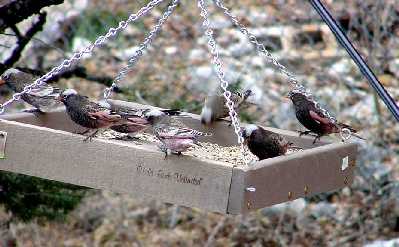
(Click on Image for full screen view)
Photo taken by CATHY PASTERCZYK on November 30, 2002of Black Rosy-Finches at deck feeder , Sandia Crest House.
Sony Mavica digital camera with a 10x optical zoom .
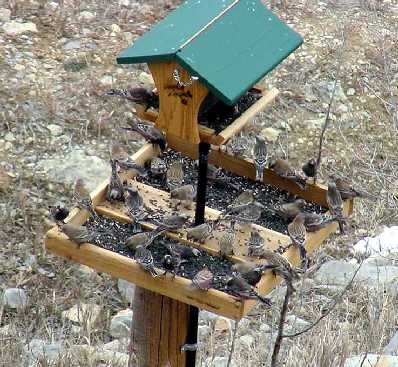
(Click on Image for full screen view)
Rosy-Finches mob the lower feeder, which is just west of the southend of the lower parking lot at Sandia Crest. Photo by CATHY
PASTERCZYK, November 30, 2002.
Sony Mavica digital camera with a 10x optical zoom .
Cole Wolf' captures the drama of a huge flock of rosy-finches mobbing a Red-tailed Hawk
(Click on images for better
view)
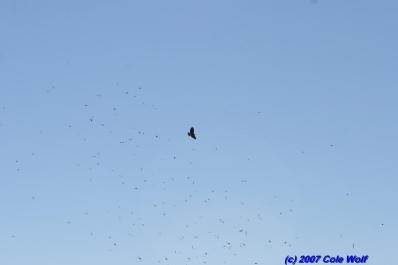
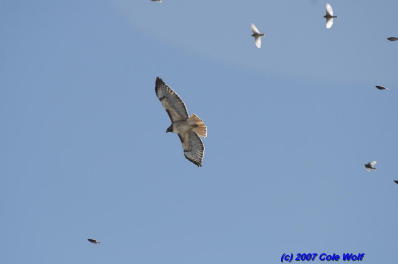
Around 10:30 AM on January 28, 2007 a Red-tailed Hawk approached the Crest House from the south. When it was within 40 meters of the feeders the entire flock of Rosy-Finches took off and started flying around it. The Rosy-Finches didn't touch the hawk but they came by within inches of it as they flew by. The hawk did not seem bothered by the flock of Rosy-Finches swirling around it, but it turned around and headed away from the Crest House. After it was about 50 meters away the Rosy-Finches stopped harassing the hawk and returned to the feeders. The whole confrontation lasted only two or three minutes, and no one got any pictures. While I was outside taking pictures of Rosy-Finches at 2:00, a Red-tailed Hawk (probably the same individual from earlier) came by and I got a few pictures of the Rosy-Finches harassing it. - Cole Wolf
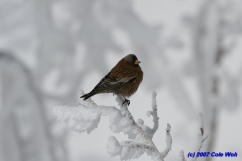
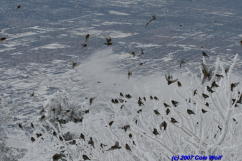
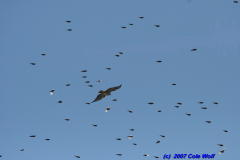
The flock during the winter of 2006-2007 numbered several hundred, mostly Black Rosy-Finches, but augmented by an unusual influx of the Gray-crowned species, of which about half were the normally rare Hepburn's (Coastal) subspecies.
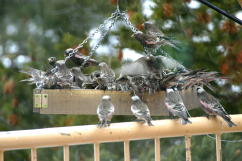 |
|
 |
|
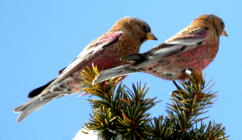 |
|
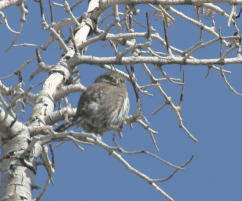 |
|
| Rosy-Finches,
Red-breasted Nuthatch and Northern Pygmy-owl at and near the
deck feeder, February 9, 2005 © Loren Hansen , Kingsley, Iowa |
|
Black and Brown-capped Rosy-Finches, January 14, 2005 © Joe Schelling, Albuquerque, NM
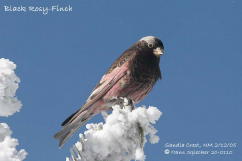
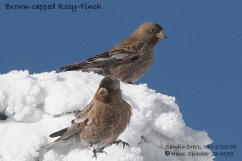
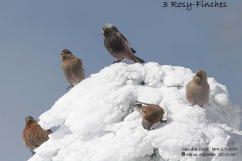
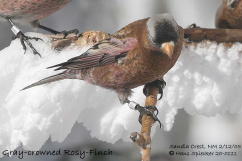
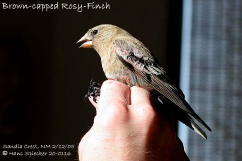
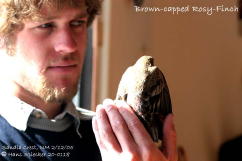
Hans Spiecker took these nice pictures on February 12, 2005. Ryan Beaulieu is holding the Brown-capped Rosy-Finch that is being banded (ringed). Note that several of the Rosy-Finches have a leg bands.
Canon 20D 100-400 IS Lens handheld
Brown-capped Rosy Finch Postage Stamp (click on image)

The 2007 Commemorative Stamp Program
Nature of America: Alpine Tundra
Pane of 10 stamps includes Brown-capped Rosy-Finch stamp
© 2006 USPS. All Rights Reserved.
(Click on Images for full screen views)
Photos of Steller's Jay and Chukar, from south end of Crest House,
February 23, 2004 © Loren Hansen , Kingsley, Iowa
Canon 10D with Canon 100 Telephoto Lens 400mm Ll with Image Stabilization.
Rosy-Finch pictures were shot at 400mm and the camera enlarges by a factor
of 1.6 so the effective focal length is 640mm.
(Click on Images for full screen views)
Rosy-Finch identification can be tricky!
Here is an ID Challenge--
Charles Howell took 5 pictures of the same bird that visited Crest House deck feeder on
March 17, 2004. Its bill is darker, something we see late in the winter. The bird could be
either a first year Black or a first year Gray-crowned. Our impression is that by March the
immature Gray-crowns show a certain amount of nice chestnut or cinnamon or rufous color,
especially around the neck and back. Rosyfinch photo #5, #4 and #2 all hint at this color,
while #1, and to some extent #3 seem to show almost black centers to the contour feathers,
suggesting it is indeed a Black. However, even immature and female Black Rosy-Finches
often show quite a bit more pink on the wings and lower belly than exhibited in photo #5,
again suggesting it is a Gray-crowned. Notice a hint of gray cheeks in #2 and #3-- could it
be an immature coastal (Hepburn's) subspecies of the Gray-crowned? Now look at the
color of the wood on the feeder and see the effect that exposure or photo editing has on its color!
Our banders have shown that it may be impossible to ID some of these "indeterminate" birds
in the field. We had been calling them immature Blacks but almost half turned out to be Gray-
crowned, based upon feather studies in the hand. Exactly which feathers or groups of feathers
were diagnostic, I do not know, but will be interested to learn. When we had a bunch of Brown-
capped juveniles last year (along with lots of Black immatures and what we thought were a few
Gray-crowned), we called them "buffies," often deciding we could not tell between Brown-
capped and Gray-crowned. Now, this winter, without any Brown-caps, we are realizing that
the "buffies" may have also included some Blacks as well!
CLICK ON THUMBNAILS FOR LARGER VIEWS. LET US KNOW WHAT YOU
THINK ABOUT IDENTIFICATION AS TO SPECIES. (Replies follow the pictures, below)
|
Photo #1 |
Photo #2 |
Photo #3 |
Photo #4 |
Photo #5 |
 |
 |
 |
 |
 |
Scott Rashid Estes Park, CO:
Could it be a cross between a gray-crowned and a black?
Alf Rider. Forest Ontario, Canada:
There was an interesting article recently from Hilton House. It was about using a conversion
to black and white and then critically comparing images. In their case it was perhaps House
and Purple finches. Could this gambit help you with separating indeterminate birds. You might
need B/W images of known birds as a reference. It seems strange to revert to B/W but it might
help to focus on shape rather than color? Not having seen any of your Rosy Finch species,
my idea might be useless...
Ryan Beaulieu & Raymond VanBuskirk, NM
(Not knowing that all the pictures were of the same bird,) Raymond and I took a look at these
photos and here's what our opinion is! This was just our guess...the photos look of separate birds...
1. Black Rosy-Finch
2. Gray-crowned Rosy-Finch (Hepburn's)
3. Gray-crowned Rosy-Finch (Hepburn's)
4. Gray-crowned Rosy-Finch (Hepburn's)
5. Gray-crowned Rosy-Finch (Interior)
Steve Cox, of Rio Grande Bird Research, who supervises the banding at Crest House:
Looking at primarily photo 5, I would be inclined to call this bird a second year, Gray-crowned.
I based this on the what appears to be the extensive cinnamon undersides, cheek and neck.
I really can't get a good feel for the bill color. It looks dark, in most of the photos but, I'm not
sure because of the focus and lighting.
I know this will not help with the ID of this bird but when we have a bird in the hand some of the
things we now take into consideration is: bill length and wing chord. However, there is overlap
between species.
On average the bill length is longer on the Gray-crown with the coastal race being slightly longer
(again on average). Wing chord is much the same. There are some age differences with primary
covert feathers and overall molt limits of the medium and greater coverts. The coloration of some
feather tips of the lesser and medial coverts can help in determining the sex. Yellow to orange for1
female and pink for male. Also wing length will give us a clue. This info can be gleaned from
Pyle's "Id Guide to North American Birds"
Bear Damage
The Black Bears of Sandia Mountain are under great pressure. A series of drought years hascaused them to seek food and water at lower elevations. In the fall of 2002, the cone and
acorn crops failed, leaving only a band of acorn producing oaks at 7000-7500' elevation.
Foraging bears were therefore forced to interact with residents. Depredation of apple orchards,
beehives, and especially unsecured garbage cans brought on complaints to the State Game
and Fish agency. Under State law, such "problem" bears must be trapped and relocated or
destroyed. Bear hunting with hounds and even late summer chases continue unabated,
causing more losses. The best estimate of the number of bears in the Sandia and Manzano
Mountains combined is total of 123. In the past two years, approximately 50% of our bear
population has been lost. This year the NM Game and Fish Commission proposed to re-
institute bow hunting in the month of September, to include both bear sexes. Since pregnant
sows do not go into their dens until mid-October, they will be chased and harassed at a time
when they must be putting on fat to carry them through hibernation. Our neighbor Jan Hayes,
who directs Sandia Mountain BearWatch, has appealed to the New Mexico Game and Fish
Commission to stop the upcoming September bow hunt.
We have lived on the edge of the Cibola National Forest since 1993. Only occasionally
were bears seen near our homes. In September and October, 2002 we had a sow with
one cub and an adult boar visit our yard. We took our feeders in each night, but one night
we forgot, and paid for our negligence. We repaired the three feeders that the bears had
torn apart. The summer of 2003 was tough for the creatures. Acorns had not yet ripened,
and last year's cubs were being turned away by their mothers to fend for themselves.
In mid-July, 2003 a yearling cub suddenly appeared in our front yard in the middle of the
afternoon. Before we could chase him off he left two of our feeders in very bad shape.
The results of both bear visits are shown below. As an added attraction, the lower right
picture shows the scat of the October 2003 bear. Note that it contains many acorn fragments.
A male Red Crossbill is gleaning the few remaining sunflower seeds from the tray feeder
(lower right picture). We have had to take in all our seed and hummingbird feeders,
but it is the price we have to pay for occupying the bear's home territory. If bears
become habituated to seeking food around homes, they are sure to get in trouble
and may be relocated or destroyed.
IF PICTURE HAS BLUE BORDER, CLICK ON IT FOR ENLARGED VIEW.
The bottom pictures show the bear after it again trashed my (repaired) feeder,
this time demolishing it.
Alaskan Brown Bear
A couple of years ago we attended a birding program at Camp Denali, which is about 90miles inside Denali National Park. One day we saw this sad grizzly bear walking along
the road. It showed the results of an encounter with a porcupine. Its snout was just full
of quills. We wondered if it ever survived.
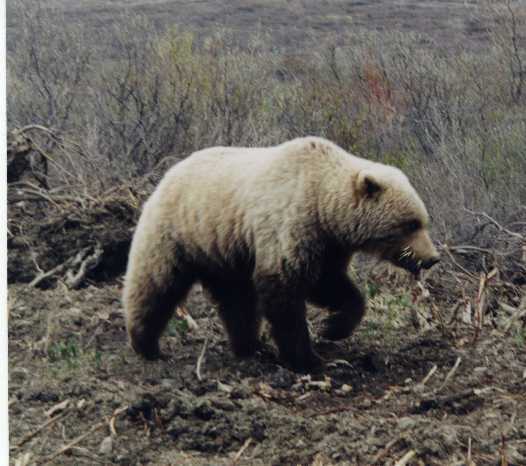
 LONG SHOT
LONG SHOT
The photo to the left is a Lewis's Woodpecker that was perched at the top af a tree about 150 yards away in the Valles Caldera.
It was taken through our Kowa 77mm scope zoomed to 60x, with
the Canon A40 optically zoomed to 3x, for an effective power of 180x. As a result,
the picture is fuzzy. Click on the image for a full screen view. For a panorama
that includes the stand of trees where the bird was sitting, click on the
Valles Caldera National Preserve panorama , below.
Rosy-Finch Graphics
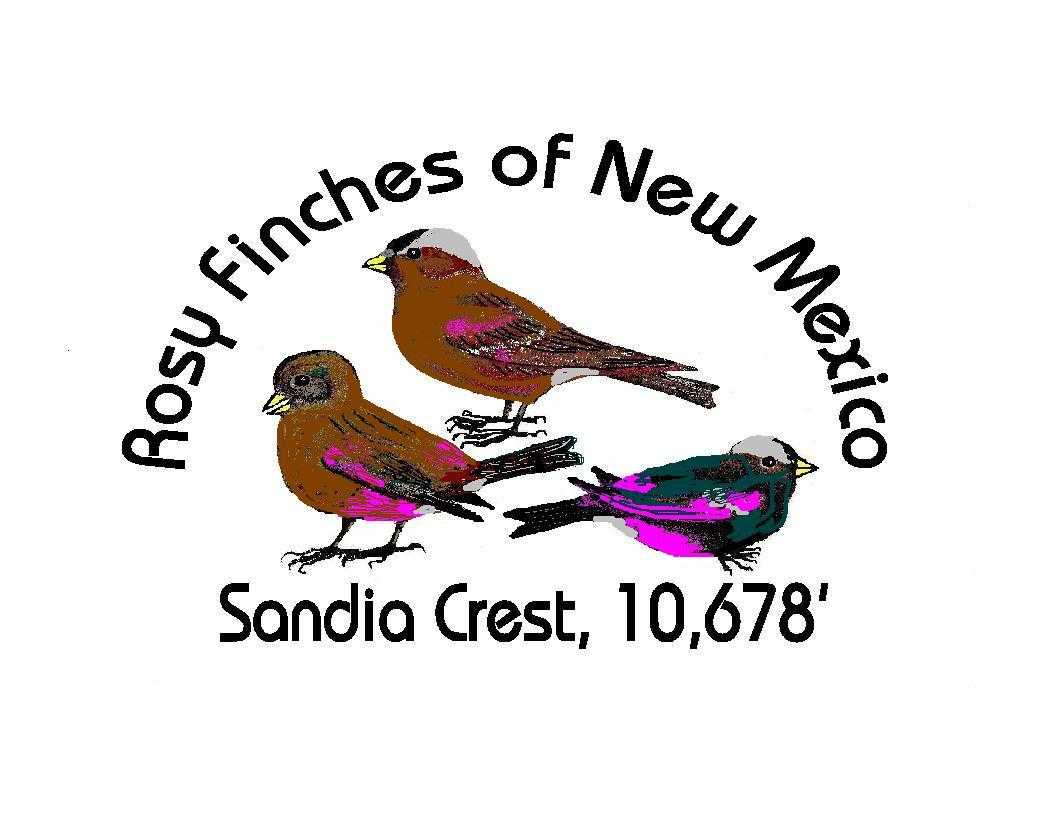
Charcoal image, computer airbrushed of (L to R) Brown, Gray-crowned and
Black Rosy-Finch. ©2003 by Ken Schneider.
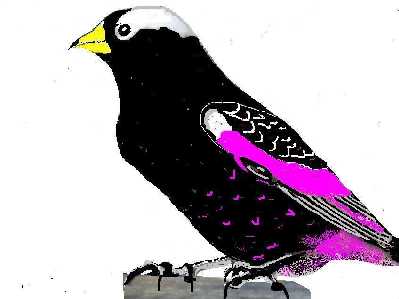
The above graphic is edited from a photo of a Black Rosy-Finch I took at Sandia Crest House.
Ken's Digiscopic Photography Equipment
My pictures (see our Back Yard Birding Calendar ) were taken with a point and shootdigital camera (Canon A40) through the lens of a 77 mm KOWA zoom (20x-60x)
spotting scope. To properly align the lens of the camera I searched for a suitable
tube, which turned out to be a plastic spice bottle (Durkee's Lemon Pepper).
It is cylindrical and flared at the bottom, where I centered and drilled a hole that
was the same diameter as the camera lens. To eliminate vignetting (dark circle
around the image) I have to increase the camera's optical zoom to 3x, so I ground
down the top of the bottle until it was just long enough to hold the lens of the
camera (zoomed to 3x) barely short of touching the eyepiece lens of the scope.
Two o-rings are fitted over the scope eyepiece to assure a snug fit for the adapter.
To finish the job I simply used electrical tape to fasten a length of wire to the
adapter and to the handle on the scope, so it is always ready for action. This
seems to be a better arrangement than having a more permanent adapter that
may require clamps, screws or other fasteners. Of course the camera must
be held in place by hand, but it can be deployed very quickly. Most pictures
require the lowest scope zoom setting since the combination provides an effective
magnification of 60x (3x times 20x). Click on the thumbnails for an enlarged
views of the rig. For more information about digiscoping, visit this "Birding on the Net" Web site
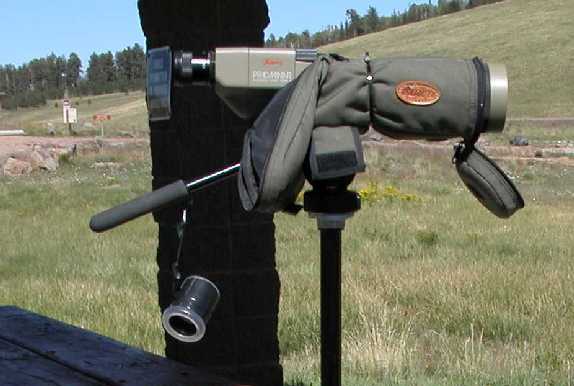 |
 |
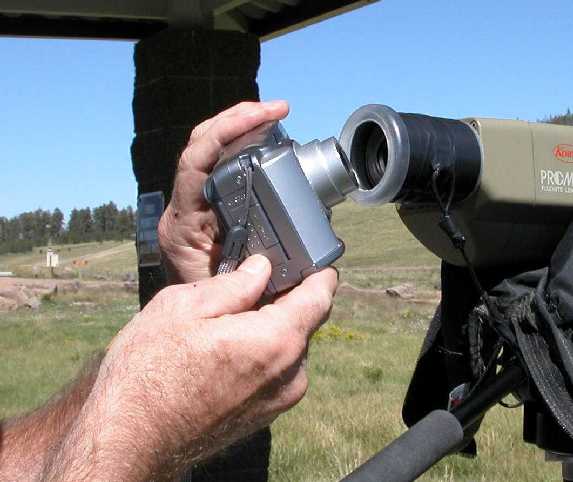 |
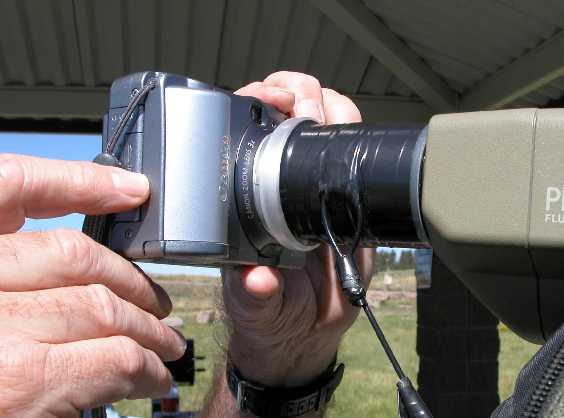 |
| Scope and Adapter | O-Rings on Eyepiece | Inserting the Camera | Ready to Shoot |
Panoramic Views of the Sandia, Manzano and Jemez Mountains
- Return to Rosy-Finches at Sandia Crest
- Phil Kelly's Rosy Finch Photos
- Chris Fagyal's New Mexico Christmas 2002 Photos including Rosy-Finches
- Scott Striet of
San Diego has some beautiful pictures of Rosy-Finches
- Bill Schmoker's Rosy Finch Photos
- Matt Victoria's Rosy-Finch Photos
| Rosy-Finches at Sandia Crest | Birding the Sandia Mountains | Cedar Crest Backyard Bird List | Birding the Manzano and Manzanita Mountains |
Please feel free to contact us at the following address:
E-mail: Ken and Mary Lou

